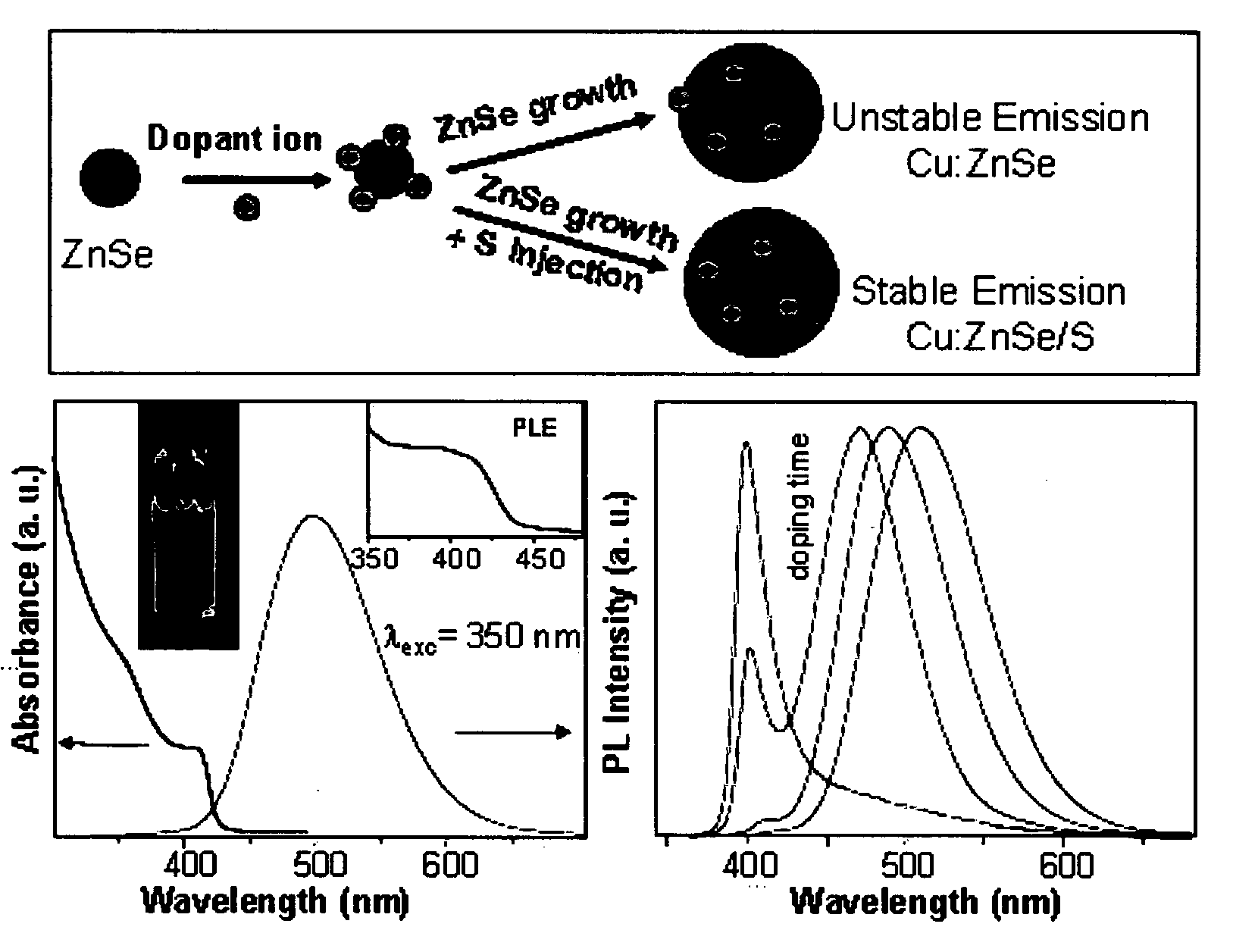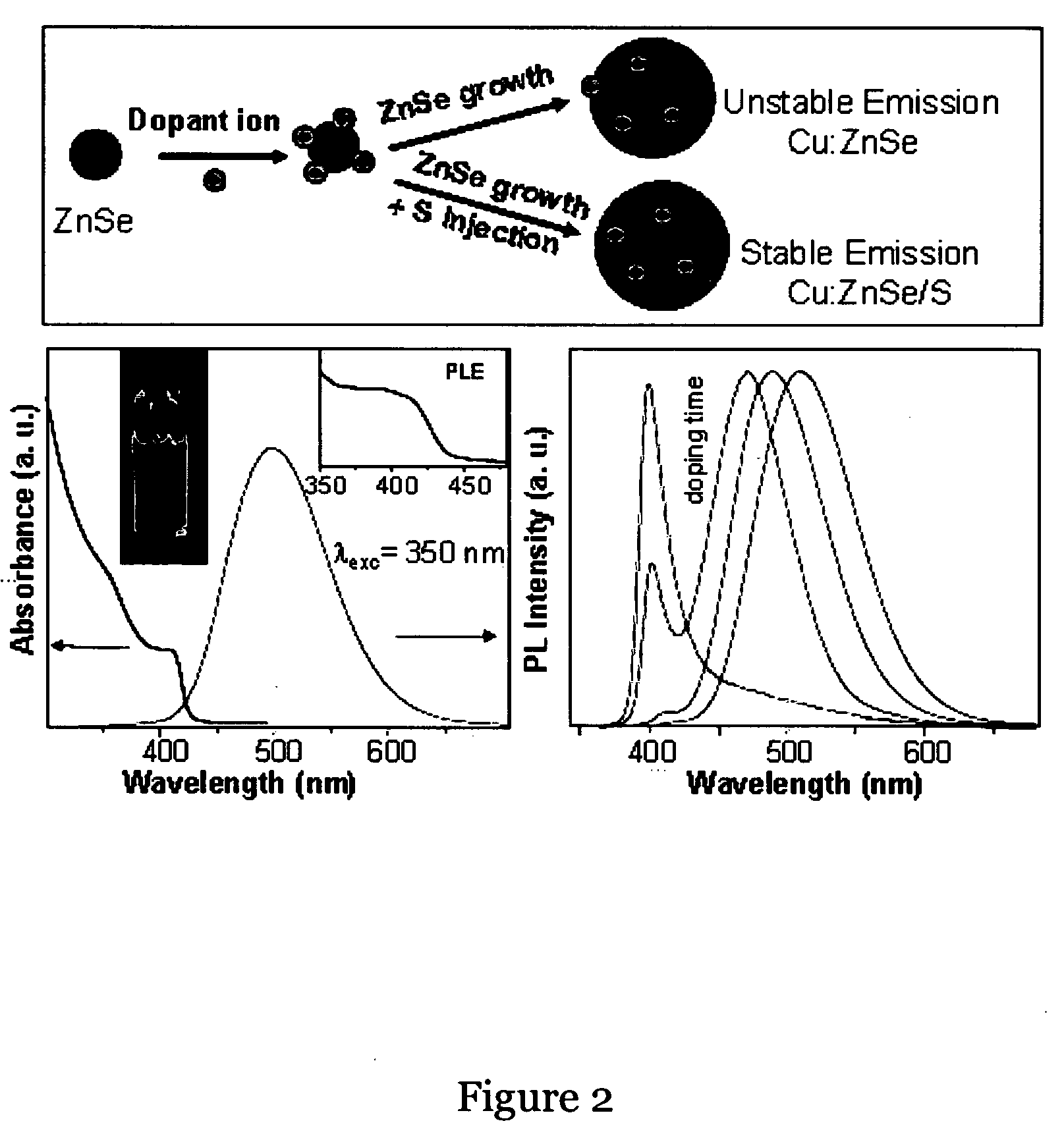Transition Metal Ion Doped Semiconductor Nanocrystals and a Process for the Preparation Thereof
- Summary
- Abstract
- Description
- Claims
- Application Information
AI Technical Summary
Benefits of technology
Problems solved by technology
Method used
Image
Examples
example 1
Process for the Preparation of Transition Metal Ion Doped Semiconductor Nanocrystals
[0077]Transition metal oxide stock solutions were prepared by taking 0.5 mmol of their respective acetates in 5 ml of oleylamine. The mixture was degassed and heated to get a clear solution. For Mn doped zinc sulfide nanocrystals first the host ZnS nanocrystals were synthesized and MnO solutions were injected during growth stage. For ZnS nanocrystals synthesis, 0.1 mmol of Zinc Stearate, Zn(St)2 and 10 ml of ODE are loaded in a 50 ml three necked flask, degassed for 10 minutes at 100° C. by purging with argon and then heated to 300° C. In a vial, 0.5 mmol S powder in 1 ml of ODE was taken with 0.3 g of ODA under argon and mixture was injected into the above reaction flask at 300° C. The temperature was reduced to 250° C. and 1 ml of MnO stock solution was injected. Then the reaction temperature was again increased to 280° C. for ZnS growth. 1.0 mmol Zn(St)2 with 0.5 mmol SA in 5 ml of ODE was injecte...
example 2
Process for the Estimation of Quantum Yield of the Transition Metal Ion Doped Semiconductor Nanocrystals at Aqueous and Non-Aqueous Medium
[0078]The QY of the nanocrystals were determined with respect to an organic dye named as Quinine sulphate.[0079]i. First absorption and emission of quinine sulphate was measured. The emission measurement was done at the excitation wavelength same to the doped nanocrystals.[0080]ii. Same procedure was applied for D-dots.
[0081]The emission area of both dye and d-dots were calculated. These emission areas were divided by their optical density (OD) value. The QY was calculated using a known formula. Quantum yield was increased by optimizing the reaction condition.
TABLE 1DopedColour ofMaterialsReported QYAchieved QYEmissionMn:ZnS18%36%Yellow-[J. Lumin., 60-61, 1994,orange275-280]Ni:ZnSNot reported5%GreenCu:ZnSNot reported 9%Blue-greenMn:ZnSe~50%30%Yellow-[Nano Lett., 2007, 7 (2),orange312-317]Ni:ZnSeNot reported25%GreenCu:ZnSe40% (unstable)40%Blue-gree...
example 3
Process for Estimating the Stability of the Transition Metal Ion Doped Semiconductor Nanocrystals in Air and Under UV Radiation in Solution and in the Precipitated Solid Form
[0082]The stability was checked by keeping the powders open to air. For the UV irradiation experiments, the nanocrystal solution taken in chloroform and continuously irradiate with UV lamp. Doping emission is found stable in presence of calculated amount of Sulfur injection in the reaction mixture with enhanced intensity.
TABLE 2Temp. stabilityTemp StabilityEmission peakWaterin 1-Octadecenein waterpHTimeCompound(nm) and QYsolubility(at 300° C.)(100° C.)stabilitystabilityMn—ZnS~586 nm,YesYesYesYes stableAt least upMax QY = 40%from pH =to 6 MonthsStable Average5-930-36%Ni—ZnS~450-460—Yes——10 Days andQY = 05%then decreasesCu—ZnS~450-480YesYesYes—At least upQY = 09%to One MonthMn—ZnSe~580YesYesYespH-6-8At least upMax QY = 40%to 6 monthsStable Average25-30%Ni—ZnSe~490-530 nm—Yes——3 monthsQY = 25% under(Under Argon)ine...
PUM
 Login to View More
Login to View More Abstract
Description
Claims
Application Information
 Login to View More
Login to View More - R&D
- Intellectual Property
- Life Sciences
- Materials
- Tech Scout
- Unparalleled Data Quality
- Higher Quality Content
- 60% Fewer Hallucinations
Browse by: Latest US Patents, China's latest patents, Technical Efficacy Thesaurus, Application Domain, Technology Topic, Popular Technical Reports.
© 2025 PatSnap. All rights reserved.Legal|Privacy policy|Modern Slavery Act Transparency Statement|Sitemap|About US| Contact US: help@patsnap.com



